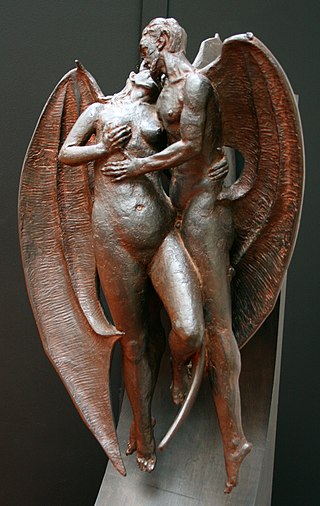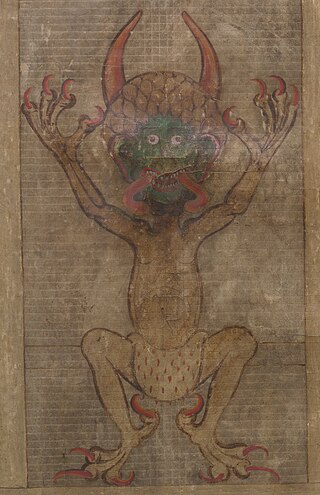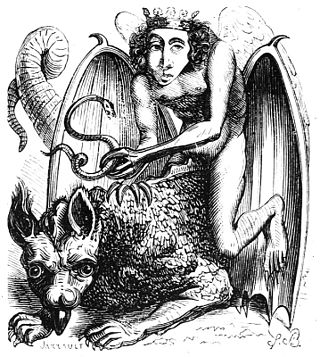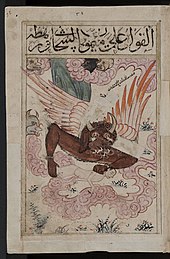
A demon is a malevolent supernatural entity. Historically, belief in demons, or stories about demons, occurs in folklore, mythology, religion, and literature; these beliefs are reflected in media including comics, fiction, film, television, and video games. Belief in demons probably goes back to the Paleolithic age, stemming from humanity's fear of the unknown, the strange and the horrific. In ancient Near Eastern religions and in the Abrahamic religions, including early Judaism and ancient-medieval Christian demonology, a demon is considered a harmful spiritual entity that may cause demonic possession, calling for an exorcism. Large portions of Jewish demonology, a key influence on Christianity and Islam, originated from a later form of Zoroastrianism, and was transferred to Judaism during the Persian era.

A devil is the personification of evil as it is conceived in various cultures and religious traditions. It is seen as the objectification of a hostile and destructive force. Jeffrey Burton Russell states that the different conceptions of the devil can be summed up as 1) a principle of evil independent from God, 2) an aspect of God, 3) a created being turning evil, and 4) a symbol of human evil.

Iblis, alternatively known as Eblīs, is the leader of the devils in Islam. According to the Quran, Iblis was thrown out of heaven, after he refused to prostrate himself before Adam. Due to the similarities of a being cast out of heaven, he is often compared to the equivalent of the Christian Satan.

Satan, also known as the Devil, and sometimes also called Lucifer in Christianity, is an entity in Abrahamic religions that seduces humans into sin or falsehood. In Judaism, Satan is seen as an agent subservient to God, typically regarded as a metaphor for the yetzer hara, or "evil inclination". In Christianity and Islam, he is usually seen as a fallen angel or jinn who has rebelled against God, who nevertheless allows him temporary power over the fallen world and a host of demons. In the Quran, Shaitan, also known as Iblis, is an entity made of fire who was cast out of Heaven because he refused to bow before the newly created Adam and incites humans to sin by infecting their minds with waswās.
Demonology is the study of demons within religious belief and myth. Depending on context, it can refer to studies within theology, religious doctrine, or occultism. In many faiths, it concerns the study of a hierarchy of demons. Demons may be nonhuman, separable souls, or discarnate spirits which have never inhabited a body. A sharp distinction is often drawn between these two classes, notably by the Melanesians, several African groups, and others. The Islamic jinn, for example, are not reducible to modified human souls. At the same time these classes are frequently conceived as producing identical results, e.g. diseases.

Astaroth, in demonology, is known to be the Great Duke of Hell in the first hierarchy with Beelzebub and Lucifer; he is part of the evil trinity. He is known to be a male figure, most likely named after the (unrelated) Near Eastern goddess Astarte.

Asmodeus or Ashmedai is a king of demons in the legends of Solomon and constructing Solomon's Temple.

Aamon, in demonology, is a Grand Marquis of Hell who governs 40 infernal legions, and the 7th spirit of the Goetia. He is the demon of life and reproduction.

Bael is a demon described in demonological grimoires such as The Lesser Key of Solomon and the Pseudomonarchia Daemonum and also in the Dictionnaire Infernal. He is described as a hoarsely-voiced king with the power to make men invisible and ruling over sixty-six legions of demons. The Lesser Key of Solomon describes him as appearing in the form of a cat, toad, human, some combination thereof, or other "diverse shapes", while the Pseudomonarchia Daemonum and the Dictionnaire Infernal state that he appears with the heads of a cat, toad, and human simultaneously.

In demonology, Beleth, also spelled Bilet, Bileth, Byleth, or Bilith, is a king of Hell who has eighty-five legions of demons under his command. He rides a pale horse, and a variety of music is heard before him, according to most authors on demonology and the most known grimoires.

There have been various attempts at the classification of demons within the contexts of classical mythology, demonology, occultism, and Renaissance magic. These classifications may be for purposes of traditional medicine, exorcisms, ceremonial magic, witch-hunts, lessons in morality, folklore, religious ritual, or combinations thereof. Classifications might be according to astrological connections, elemental forms, noble titles, or parallels to the angelic hierarchy; or by association with particular sins, diseases, and other calamities; or by what angel or saint opposes them.

Fallen angels are angels who were expelled from Heaven. The literal term "fallen angel" does not appear in any Abrahamic religious texts, but is used to describe angels cast out of heaven or angels who sinned. Such angels often tempt humans to sin.

Azazil is a figure in Islamic tradition, and believed to be the original name of Satan (Iblīs). The name does not appear in the Quran, however, is frequently mentioned in tafsīr. According to a ḥadīth by ibn Abbas, Satan was once an angel called ʿAzāzīl or al-Ḥārith. He states that God created most angels from "light" (Nūr), but ʿAzāzīl and the angels with him from "poisonous fire". The djinn were created from "a mixture of fire".
The Devil, appears frequently as a character in literature and various other media. In Abrahamic religions, the figure of the Devil, Satan personifies evil.

Beelzebub or Baʿal Zebub, also spelled Beelzebul or Belzebuth, and occasionally known as the Lord of the Flies, is a name derived from a Philistine god, formerly worshipped in Ekron, and later adopted by some Abrahamic religions as a major demon. The name Beelzebub is associated with the Canaanite god Baal.

A shaitan or shaytan is an evil spirit in Islam, inciting humans and jinn to sin by whispering in their hearts. Although invisible to humans, shayatin are imagined to be ugly and grotesque creatures created from Hellfire. In Islamic tradition, and in contrast to Christian tradition, devils are not a supernatural manifestation but psychological phenomena.

Div or dev are monstrous creatures within Persian lore. Most of their depictions derive from Persian mythology, integrated to Islam and spread to surrounding cultures including Armenia, Turkic countries and Albania. Despite their Persian origins, they have been adapted according to the beliefs of Islamic concepts of otherworldly entities. Although they are not explicitly mentioned within canonical Islamic scriptures, their existence was well accepted by most Muslims just like that of other supernatural creatures. They exist along with jinn, peri (fairies) and shayatin (devils) within South and Central Asian demon-beliefs.
In Islam, Nār as samūm refers to a type of infernal fire or hot wind. The term is related to a type of storm in the deserts of the Arabian Peninsula. According to the Quran, the damned will be tormented in samūm and demons are said to be created from samūm.















